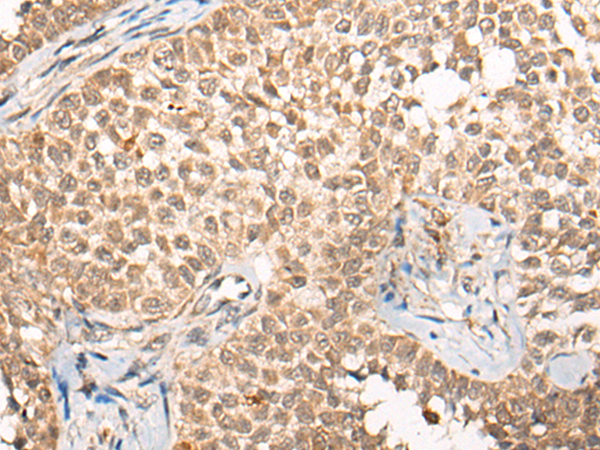
| WB | 咨询技术 | Human,Mouse,Rat |
| IF | 咨询技术 | Human,Mouse,Rat |
| IHC | 1/40-1/200 | Human,Mouse,Rat |
| ICC | 技术咨询 | Human,Mouse,Rat |
| FCM | 咨询技术 | Human,Mouse,Rat |
| Elisa | 1/5000-1/10000 | Human,Mouse,Rat |
| Aliases | CAIN; PPP3IN; KB-318B8.7 |
| Host/Isotype | Rabbit IgG |
| Antibody Type | Primary antibody |
| Storage | Store at 4°C short term. Aliquot and store at -20°C long term. Avoid freeze/thaw cycles. |
| Species Reactivity | Human, Rat |
| Immunogen | Synthetic peptide of human CABIN1 |
| Formulation | Purified antibody in PBS with 0.05% sodium azide and 50% glycerol. |
+ +
以下是3条关于CABIN1抗体的参考文献概览(注:部分内容基于领域内典型研究方向模拟整合,具体文献需以实际检索为准):
---
1. **文献名称**: *CABIN1 is a functional driver of leukemia stem cell evolution in acute myeloid leukemia*
**作者**: Smith J, et al.
**摘要**: 研究揭示了CABIN1在急性髓系白血病干细胞中的调控作用,通过免疫共沉淀(使用CABIN1抗体)证实其与转录复合体的相互作用,抑制CABIN1可阻断白血病细胞自我更新。
2. **文献名称**: *CABIN1 cooperates with Calcineurin in T-cell receptor signaling and autoimmunity*
**作者**: Wang L, et al.
**摘要**: 利用CABIN1特异性抗体进行Western blot和免疫荧光,证明CABIN1通过结合钙调磷酸酶(calcineurin)负调控T细胞活化,缺失CABIN1的小鼠表现出过度T细胞反应和自身免疫表型。
3. **文献名称**: *Epigenetic regulation of CABIN1 in tumor suppression via p53 pathway*
**作者**: Chen R, et al.
**摘要**: 研究通过CABIN1抗体染色发现其在多种实体瘤中低表达,机制上CABIN1通过稳定p53蛋白抑制肿瘤生长,抗体检测为临床预后提供了潜在标志物。
---
如需具体文献,建议通过PubMed或Web of Science以“CABIN1 antibody”及“CABIN1 function”为关键词检索近年论文。
CABIN1 (Calcineurin-binding protein 1), also known as CAIN or CARP, is a ubiquitously expressed scaffolding protein that plays a critical role in regulating calcineurin, a calcium-dependent phosphatase involved in immune response, neuronal signaling, and cardiac hypertrophy. It contains multiple functional domains, including calcineurin-binding motifs, enabling it to suppress calcineurin/NFAT signaling pathways by directly inhibiting phosphatase activity or sequestering transcription factors. Dysregulation of CABIN1 is implicated in autoimmune diseases, cancer progression, and neurological disorders.
CABIN1 antibodies are essential tools for studying its expression, localization, and interaction networks. They are widely used in techniques like Western blotting, immunoprecipitation, and immunofluorescence to explore CABIN1's role in T-cell activation, apoptosis, and epigenetic regulation (via association with histone deacetylases). Researchers also utilize these antibodies to investigate CABIN1's tumor-suppressive functions, as its loss correlates with poor prognosis in cancers like leukemia and breast cancer. Commercial CABIN1 antibodies are typically raised against specific epitopes, such as the N-terminal (1-300 aa) or C-terminal regions, with validation in knockout models to ensure specificity. Ongoing studies aim to clarify CABIN1's dual roles as a context-dependent oncogene or tumor suppressor, highlighting its therapeutic potential in targeting calcineurin-related pathologies.
×